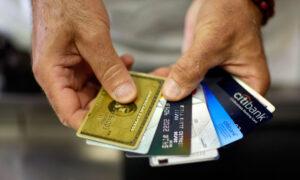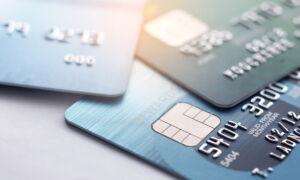A sharp rise in the number of Americans pulling money out from their 401(k) accounts is the latest sign that the U.S. consumer may be starting to buckle as the pandemic-era jump in excess savings continues to be depleted and people are relying more and more on high-interest credit cards and retirement nest eggs to prop up spending.
A new report from Bank of America (BofA) shows that so-called hardship withdrawals (or “hardship distributions”) from retirement plans rose by more than 10 percent in the third quarter.
Meanwhile, separate research from the Federal Reserve Bank of New York shows that U.S. credit card debt has hit a record high—bringing with it an increase in credit card debt delinquencies. This suggests consumers are racking up debt that they can’t necessarily afford to pay off in order to continue shopping, given that consumer spending has remained surprisingly robust.
More than 18,000 people dipped into their retirement savings in the third quarter, the BofA report shows, up 13 percent from the second quarter and 27 percent since the first quarter.
Even though BofA doesn’t track the specific reasons for the hardship withdrawals, the current state of the economy is likely one of them.
The law allows retirement plans to distribute funds after certain events, including when participants suffer a hardship. The IRS defines a hardship distribution as a withdrawal made in response to an “immediate and heavy financial need” and must be limited to the amount necessary to satisfy the financial need.
Borrow to Spend
The latest data on household borrowing, released on Nov. 7 by the New York Fed, show that Americans are increasingly turning to their credit cards to cover everyday expenses, sending credit card debt soaring by $154 billion over the past year, the biggest annual jump in history.In the third quarter alone, credit card debt rose by $48 billion, and it was the eighth consecutive quarter with a year-over-year increase. Total credit card debt now stands at a whopping $1.079 trillion.
But along with the jump in credit card debt, there’s been a sharp increase in the number of Americans who have fallen behind on their payments.
The percentage of credit card debt that transitioned into serious delinquency (defined as 90 or more days delinquent) rose from 3.69 percent in the third quarter of 2022 to 5.78 percent in the third quarter of 2023. This is the largest delinquency rate increase out of all credit product types.
Credit Card Defaults Rise
Credit card delinquencies have now surpassed pre-pandemic levels and continue to rise, according to analysts at the NY Fed.They wrote in a blog post that it’s difficult to pin down the exact reason for the rising delinquency rates, which have been going up for nearly all types of credit products since the middle of 2021.
However, they suggested that the rise could be due to “shifts in lending, overextension, or deeper economic distress associated with higher borrowing costs and price pressures,” issues that have been a known problem for some time, as high inflation has forced the Fed to hike rates, raising borrowing costs.
A key question is whether the jump in household debt delinquency transition rates (which rose for all types of credit products except home equity lines of credit and student loans) means the writing is on the wall for consumer spending, which so far has remained surprisingly solid.
U.S. consumer spending exited the third quarter on a strong note, as households in September boosted purchases of cars and went on trips, as revealed by the latest data from the Commerce Department’s Bureau of Economic Analysis.
“U.S. consumers still had some gas left in the tank last month that risks carrying into the current quarter,” Sal Guatieri, a senior economist at BMO Capital Markets in Toronto, Canada, told Reuters.
“While we still expect spending and the economy to downshift sharply in the fourth quarter, the risk is that both will keep running hotter than the Fed needs to subdue still-stubborn services inflation,” he added, suggesting that the Fed might continue to raise interest rates to try to stamp out stubbornly high price pressures.
Even though personal income rose by 0.3 percent in September, it dropped for the third straight month when accounting for inflation and taxes.
“That is not sustainable,” James Knightley, chief international economist at ING in New York, told Reuters. “Savings are finite and are being exhausted at a rapid rate, with various estimates suggesting that excess savings accrued during the pandemic could be exhausted in the first half of next year.”
Part of what could be driving the increase in hardship withdrawals, credit card debt, and household debt delinquency rates is the steady depletion of excess savings, which were built up during the pandemic thanks to government aid such as stimulus checks.
Although it’s estimated that more than $280 billion in COVID-19 relief funding (out of a total of about $4.2 trillion) was stolen by fraudsters, a recent report shows that many Americans used their stimulus checks to pay off their credit card debts.The report from the U.S. Government Accountability Office revealed that the share of cardholders who paid off their credit card debt during the COVID-19 pandemic reached the highest in recent years. At the same time, late payment and default rates fell to historic lows during the pandemic.
Now, as Americans have put the pandemic behind them, credit card balances have been on the rise—along with credit card debt and defaults.







